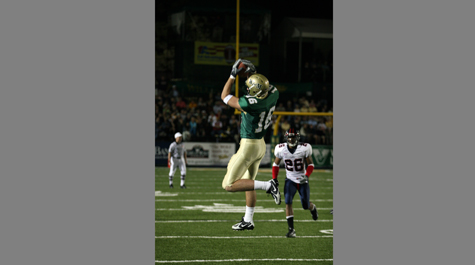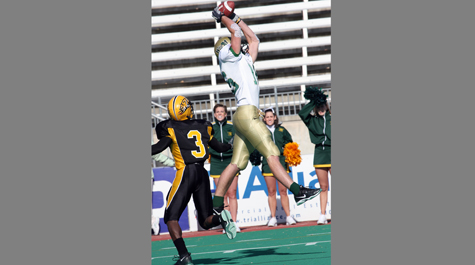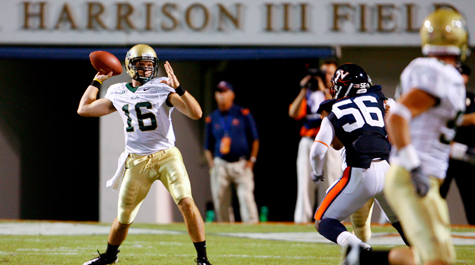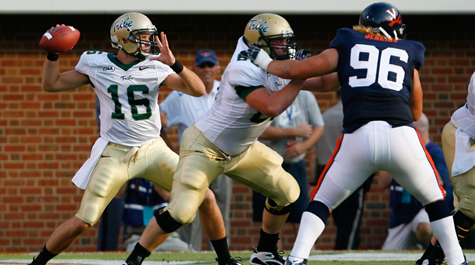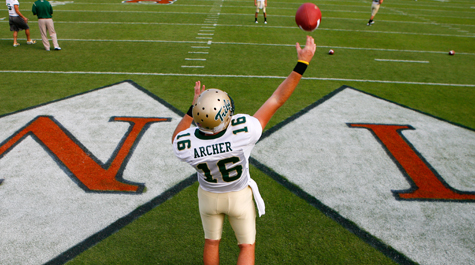Archer joins Tribe's long list of star quarterbacks
R.J. Archer’s life and career at William & Mary have been atypical in almost every way.
One of the captains of the nation’s fifth-ranked team entering Saturday’s key Colonial Athletic Association contest with eighth-ranked New Hampshire, Archer is the first Tribe quarterback in 15 years not to gain the starting job until his senior season. That’s not to say he was unworthy before, just that coach Jimmye Laycock had a stockpile of experienced passers ahead of him.
Never one to waste time, Archer accepted an invitation to move to wide receiver for two seasons, where he finished second on the team in catches each campaign. Before last season, Laycock asked him to return to quarterback, even though it meant sitting on the bench behind Jake Philips.
“Each step along the way I looked at as a new challenge for me,” said Archer, who grew up in Earlysville, located in the shadow of Mr. Jefferson’s “second” university. “I’d never played receiver before, but I like to challenge myself each day. It turned out great for two years; I was happy at receiver.
“Then coach said the team could use me back at quarterback. My answer to him has always been, ‘Whatever’s best for the team.’ I thought it would be good to get back into it and I was looking forward to this season, where I thought I’d be sort of the heir-apparent. Everything’s worked out.”
And how.
Archer is third in the CAA in total offense, averaging 221.3 yards per game. He has thrown just four interceptions in 274 pass attempts, and his 1,829 yards passing is the league’s second-highest total. Depending on how the Tribe fares in their last two games, Archer should be a strong candidate for all-conference honors.
“Number one, he's a good athlete, number two he's smart and number three he's been in the program,” Laycock says. “He can do all the things you want him to do.”
That includes working towards his degree in economics, with a minor in psychology. If you only see Archer on Saturdays, it’s easy to forget how rigorous the life of a College student-athlete can be, particularly in-season.
A typical day finds Archer rising around 6, followed by breakfast and an 8 a.m. class. Other days, he has two classes before lunch. Three times a week, he lifts weights then it’s off to another class before lunch.
When that’s done, Archer tries to “sneak off” to the Laycock Center to watch film of the upcoming opponent before heading to the locker room to dress for practice and another film session. A couple of nights a week, coaches schedule meetings and film sessions after practice, by which time Archer must feel like Roger Ebert. Then dinner.
“By the time that’s over, it’s time to do a bit of schoolwork – usually a couple of hours worth – and go to bed,” he said. “I don’t usually even get to start studying until about 8.”
Saturdays, of course, are consumed with the game, which leaves Sunday to play academic catch-up at home or inside Swem Library. Even then, sometimes he’ll watch film of the previous day’s contest and take any necessary medical treatment. Add it up and Archer easily devotes the NCAA limit of 20 hours per week for practice and competition and maybe another 20 for lifting, film sessions, etc.
“You don’t really think about it being a fulltime job until people start to ask how time you put into it,” Archer said. “It’s a lot, but I really don’t know what I’d do without it. Maybe I’d have too much free time and wouldn’t be able to focus well enough. I think it’s good, at least for me . . . It keeps me focused and on schedule.”
There aren’t many colleges in the country where academics serves as a rallying cry for a football team. It’s no secret, of course, but W&M is different. Last May, the National Collegiate Athletic Association lauded the College for its Academic Progress Rate (APR) in six sports: football, men’s and women’s gymnastics, women’s indoor and outdoor track and women’s volleyball. The award was based on the eligibility, retention and graduation statistics of each scholarship student-athlete from the 2004-05, 2005-06, 2006-07 and 2007-08 academic years.
How significant was the football citation? Of the more than 225 schools that field Division I and I-AA football programs, only 23 teams were honored. Among them were Brown, Cornell, Dartmouth, Duke, Harvard, Princeton, Rice, Stanford, West Point, the Naval Academy and Yale.
“I think we enjoy the pressure that comes with being a student-athlete here,” Archer said. “It’s definitely a challenge. Some people can’t handle it, but the guys we have on the team definitely can. Just getting into school here is good enough on its own. Then you add the rigors of football to the course work, it makes you feel special.”
Archer said the older players try to mentor the newcomers by guiding some of their course selections until they have become acclimated to W&M.
“The athletic department does a good job of helping us balance out our schedules,” Archer said. “The football players say there’s only one problem with that: there aren’t any easy classes.
“When we get out into the work world after this, hopefully employers will look say, ‘You had a fulltime job and took all of these difficult classes?’ I think it will pay off. It’s tough, but we’re competitors at heart.”
There are more immediate tests facing the Tribe, crucial season-ending games against New Hampshire and defending national champion Richmond, almost certainly followed by the team’s first postseason berth since 2004. Over the last five seasons, no CAA team with eight or more victories has failed to make the NCAA playoffs.
In 2008, the Tribe got to seven wins before ending the season with losses to then-No. 1 James Madison and Richmond. That gave the selection committee the ammunition it needed to exclude W&M from the postseason.
“That was our main thing this year: take it in our own hands,” Archer said. “We control our destiny as far as the playoffs are concerned and that’s the position we want to be in.”
 Skip to main content
Skip to main content

